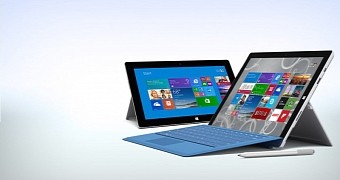Microsoft launched the new Surface Pro 3 tablet in May, and since then, sales of the new model have been going particularly well, especially when taking into account the issues that have been experienced with older versions of the device.
It turns out that Microsoft is so pleased with Surface Pro 3 sales that the company is now planning to expand the Surface lineup with a new and bigger device that could feature a 13- or a 14-inch screen.
The report comes via Digitimes, which also writes that sales of Surface Pro 3 have improved in the last few months and Microsoft wants to make the most of consumers’ appetite for larger tablets with a new model.
The Surface Pro 3 comes with a 12-inch screen and is currently the flagship model in the whole Surface series, boasting excellent hardware specifications and offering full support for legacy Windows software.
Specifically aimed at business customers
The Surface Pro 3 is the kind of device specifically developed for business users and Microsoft said this from the very beginning, trying to emphasize that the hefty price tag, which is approximately $1,950 (1,500 euro) in the United States for the top of the range model, didn’t really fit the consumer market.
The same will happen with the even larger Surface Pro tablet which, according to the aforementioned source, would come with state-of-the-art hardware and run a full version of Windows.
Chances are that Microsoft could introduce it in spring 2015, when it also plans to release Windows 10, so the new tablet could run the revamped version of the operating system from the get-go.
Surface Pro 3 can replace your laptop
The Surface Pro 3 comes with a 12-inch screen and runs the full version of Windows 8.1 Pro, but also includes powerful hardware which, according to Microsoft, should help replace any laptop out there.
Microsoft offers Surface Pro 3 buyers a choice of three different CPU versions, starting with an Intel Core i3 and ending with i7. Buyers can get as much as 8 GB of RAM and up to 512 GB of storage space, with increased capacity available via the cloud-based service OneDrive.
The device is already up for grabs in 28 markets across the world and sales are going pretty well, so this is the main reason Microsoft is trying to make the most of this and bring an even larger device to the market. Of course, the bigger the screen, the more chances to replace a laptop, so Microsoft might actually hit the jackpot this time.

 14 DAY TRIAL //
14 DAY TRIAL //